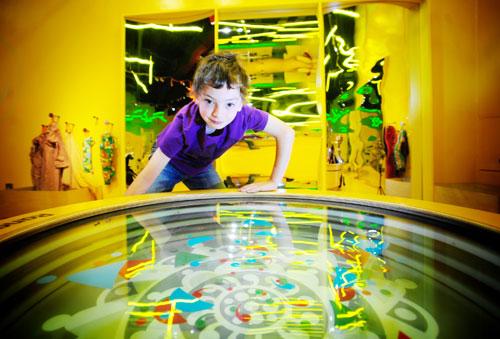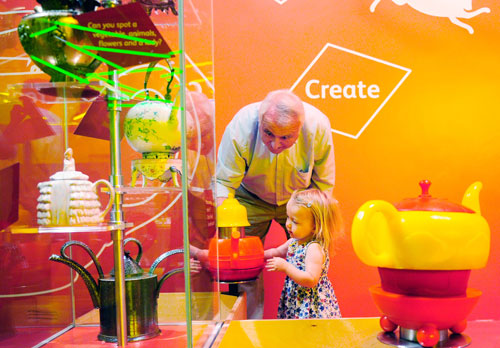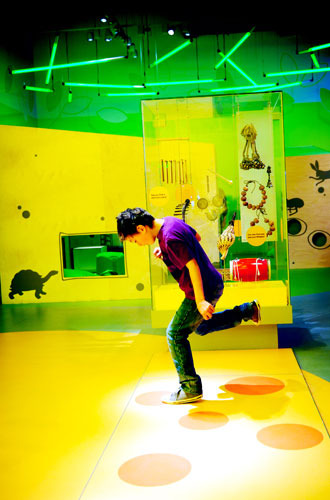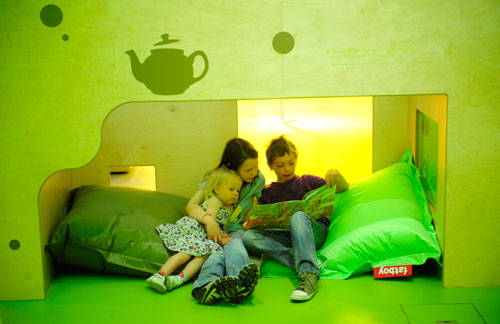“Can I have my family back please? Husband+2 last seen entering museum AM today. If they’re staying for tea, I need to know.” Twitter, 2 August 2011
When we flung open the new street-level doors to the National Museum of Scotland at the end of July after a three-year closure and redevelopment project, we in the Learning and Programmes team hoped that there would be families of all ages amongst the crowds. And we weren’t disappointed, with grandparents, parents, teenagers and overexcited toddlers all raring to go. But where should they go first?
Our old, rather tired animal displays had always been a ‘natural’ draw for our youngest visitors, so we were confident that our revamped Natural World galleries would remain a key destination for families even without the lure of our new Tyrannosaurus rex cast skeleton.
But we were also opening six new World Cultures galleries. Many of these objects had not been on display before, and we knew from speaking with family visitors early in the project that they felt less confident about this area of our collections. So we decided to develop a gallery dedicated to families with children under eight, an inspiring space for them to actively engage with our World Cultures and Art and Design collections as a starting point for exploring the other new displays.
In the first hour after opening, 6000 visitors began to find their way around the new museum spaces. The looks on the faces of the first children to discover Imagine made all our hard work immediately worthwhile.

Imagine is a bold, bright space where museum objects are brought to life through music, stories, creativity and play. Children know immediately it is a space for them – colourful strips of light fill the roof void, and vivid swathes of red, green, yellow and orange vinyl cover the floor. Everything is a little bit nearer the floor, with peepholes, flaps to lift and slide, and spaces too small for grown-ups.
Objects are central to the Imagine gallery ethos, acting as a focal point for each of the interactive experiences on offer. After months of detailed development, it was wonderful to watch small hands lift our giant ‘slices’ of teapot, selecting a yellow base, a red handle, an orange body and a yellow lid to create their own personal design, inspired by a tower of teapots from across our collections.

We tried to keep the written interpretation to a minimum, but we have included simple questions alongside the objects to encourage observation, ideas and opinions. They give parents and grandparents a starting point for a conversation without having to know facts and figures, and allow older children to take a lead. ‘Can you find the biggest, and the smallest?’ or ‘Which one do you like best and why?’ are questions they can take with them to other galleries as they continue to discover together.
The ‘Celebrate’ area is introduced by a larger-than-life Chinese dragon suspended from the ceiling, created by artist Kim Bergsagel as part of a community engagement project with local groups. Of course, celebration is all about getting together, dressing up and having fun, so here children can try on costumes from Africa, China and the Caribbean, play a range of percussion instruments and even dance on the musical stepping stones.


Most of the activities are sensory, tactile, low-tech. One of the most popular areas is ‘Play’, which we developed specifically for toddlers. A low, curved bench has six hidden compartments containing toys, some from our collections and others more recognisable examples, like a finger-puppet story book and Mr Potato Head. The simple act of revealing these, by lifting or sliding a flap or opening a drawer captivates young children and entices them to investigate further. This section also has age-appropriate toys that reflect the rest of the gallery, such as a play tea set, percussion instruments and baby board books. The built-in seating creates a safe environment for cruising babies and young toddlers, while giving parents and grandparents a much-needed chance to rest their feet!
Young visitors can also develop their own story-building abilities and literacy skills. One of the more unusual objects in the gallery is a silk sculpture of a sardine tin with a mermaid inside it, which forms the centrepiece of a jigsaw-based activity. Simple story elements are depicted in words and pictures for visitors to put together to create their own story of how the mermaid got into the tin, and what happened when she was found. This is proving to be a truly collaborative experience within families, as younger children are led by the visual stimulation of the fun cartoon images and older ones enjoy piecing the words together in silly sentences.
And when they want to a quieter space to relax, they can get comfy on a bean bag and share stories in the Story Corner.

This area features animal-themed objects from around the world, from tiles showing scenes from Aesop’s fables to tiny Japanese figurines in the shape of a tiger and a monkey, and visitors can explore animal stories from many cultures through a wide range of children’s books. We have also developed story bags to connect some of the books with objects elsewhere in Imagine and the wider museum galleries. As well as acting out ‘The Hare and The Tortoise’ with fabulous glove puppets, families can also test their knowledge of animal speeds with an information book and a flashcard quiz, before being encouraged to find the Animal Sprint activity in our Natural World galleries, where they can be part of a virtual race with a cheetah, a hippo and a crocodile!
So is it working? In a word, yes! Imagine is proving a firm favourite, encouraging frequent repeat visits. And in the words of one of them – “Give a 5-year-old the casting vote on ‘what to do today’ and chances are you’ll end up at the National Museum of Scotland…”
Stop press! National Museum of Scotland has been longlisted for a Kids In Museums Family Friendly Award 2012! The short list will be announced in April and the overall winner in May. Thanks to all the visitors who nominated us!
